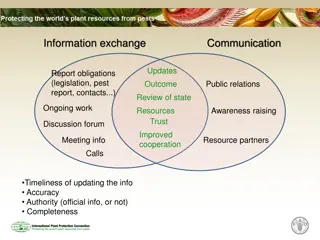Overview of Plant Variety Protection and International Treaties
Plant variety protection is essential for biodiversity and sustainable agriculture. Various international conventions and treaties such as CBD, UPOV, and TRIPs impact the legal framework for protecting plant varieties. The UPOV organization aims to safeguard plant breeders' rights separately from patent law, while TRIPs addresses the availability of patents for inventions in the field of technology. The PPVFR Act passed in 2001 establishes a system to protect plant varieties and farmer rights, stimulating research investment and seed industry growth to provide improved planting materials to farmers.
Download Presentation

Please find below an Image/Link to download the presentation.
The content on the website is provided AS IS for your information and personal use only. It may not be sold, licensed, or shared on other websites without obtaining consent from the author.If you encounter any issues during the download, it is possible that the publisher has removed the file from their server.
You are allowed to download the files provided on this website for personal or commercial use, subject to the condition that they are used lawfully. All files are the property of their respective owners.
The content on the website is provided AS IS for your information and personal use only. It may not be sold, licensed, or shared on other websites without obtaining consent from the author.
E N D
Presentation Transcript
PLANT VARIETY PROTECTION (LS SEC IV-IPR) By: Dr. Neha Yadav Deshbandhu College University of Delhi
Genesis of plant variety protection act Various convention/treaties affecting biodiversity CBD IUPGR UPOV TRIPs
Convention on biological diversity Legal binding document signed in Rio de Janerio earth-1992,170 member countries Objectives: Conservation of biodiversity Sustainable use of biodiversity Fair and equitable sharing of the benefits Article 15 recognise sovereign rights over national resource
UPOV An intergovernmental organisation which cooperates with WHO Presentl 40 member mostly from developed world Objectives: Plant breeder s rights and protection of plant variety UPOV encourages the adoption of sui-generis law for protection of new plant varieties by creating distinct system outside of patent law
TRIPs Article 27 Patent shall be available for any invention, whether product or process in field of technology Article 27.3(b) Plant and animal other than microorganisms and essentially biological processes for the production of plant and animal other than microbial processes However members shall provide the information for the protection of plant varieties either by patents or by an effective sui-generis system or by any combination of thereof.
Status of protection of plant variety and farmer right act PPVFR act passes in 2001 Rules are notified on September 2003 Authority established on December,2006 and June,30 2009 PPVFR act already enacted
Objective To provide for the establishment of an effective system for protection of plant variety To provide for the rights of farmers and plant breeder To stimulate investment for research and development and to facilitate growth of the seed industry To ensure availability of high quality seed and planting material of improved variety to farmers
Criteria for registration of variety Section 15 of act: Novelty Distinctiveness Uniformity Stability
Registerable plant variety Noble variety Extant variety Essentially derived variety Farmer variety
Application for registration Every application for registration will have to be accompanied with the following information Denomination assiged to such variety by the applicant An affidavit sworn by he applicant that such variety does not contain any gene or gene sequence involving terminator technology The applicant should be in such form as may be specified by regulations A complete passport that a of the parental line from which the variety has been drived along with the geographical location in India from where the genetic material has been taken and all such information related to the contributio if any of farmer village community institution or organization in breeding evolving or developing the variety A statement containing a brief description of the variety brining out its characteristics of novelty distinctiveness uniformity and stability has required for registration Such fees as may be prescribed Containing a declaration the genetic material or parental material acquired for breeding evolving or developing variety has been lawfully acquired
Period of protection In case of trees and vines 18 year from date of registration of variety In case of extent variety 15 years from the date of registration of variety In case of other variety 15 years from date of registration of variety
Farmers rights Entitled to save,use,resow, exchange or sell his farm produce Compensation for failure of expected performance of registered variety Protection against innocent infringement Exemption from payment of DUS testing fee
Researchers rights The use of any variety for conducting research The use of a variety for the purpose of creating other varieties
Breeders rights Rights to: Produce Sell, market, distribute Import/export seeds of the variety Breeder authorization for production, commercial exploitation of plant variety Penalties for infringement of breeder right
Communities rights The right of community: Provide for compensation for the contribution of communities in the evolution of new plant variety
Compulsory license The authority can grant compulsory license in case of any complaints about the availability of the seed of any registered variety to public at a reasonable price.The license can be granted to any person interested to take up such activities after the expiry of a period of three years from the date of issue of certificate of registration to undertake production distribution and sell of the seed or other propagating material of variety
Benefit sharing Sharing of benefits accruing to a breeder from a variety develop from indigenously derived plant genetic resources has also been provided.The authority may invite calms of benefits, sharing of any variety register under the act,and shall determine the quantum of such award after ascertaining the extent and nature of benefits calm after providing an opportunity to be heard to both the plant breeder and the calmer.
National gene fund Constituted by central government from benefit sharing proceed, annual fees, community compansation utilize for conservative of genetic resources and compansation to breeder, farmer, community
Source: Intellectual Property Rights Law, Concept and cases, by Arun Kumar Maurya, Book Age Publications, ISBN: 978-93-83281-45-9 Patil NS., 2016. Farmers Rights and Intellectual Property Rights Protection of Plant Varieties in India. Rural South Asian Studies Journal, Vol. II, No. 2 Check these links: https://www.downtoearth.org.in/news/agriculture/farmer s-rights-are-a-hot-potato-64535 http://www.farmersrights.org/state/countries_india.html























